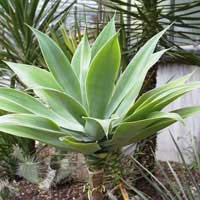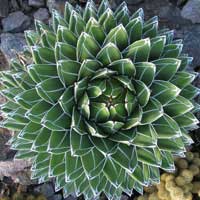 Full List of Fruits
Full List of Fruits  Agave Plant
Agave PlantAgave Plant
Scientific name - Agave Americana
Derived from the plant used to make tequila, agave is a natural sweetener similar to honey which is native to the southern and western United States and central plus tropical South America. Since it's a plant that is highly luscious its fruits provide a higher health restoration.
Agave plants are indigenous to Mexico and southwestern states like Arizona and New Mexico. They are eaten in the form of agave nectar- thin syrup that is often used as an alternative to traditional granulated sugar. One can have the benefits of getting its key nutrients by eating raw, cooked or dried which can't be achieved through the syrup. The plant of agave gives out 4 edibles namely the flowers, the leaves, the stalks or basal rosettes, and the sap. It is during its final season, the plant will start producing pounds of edible flowers. Having said that, it is also used as a diuretic!
![]() Nutritional Value of Agave Plant
Nutritional Value of Agave Plant
With no inclusion of agave nectar, other forms of agave are a good source of iron; following are its nutrient rundown: 100gms
 Raw agave contains 1.8 milligrams of iron, on the other hand, cooked agave contains 3.55 milligrams of iron.
Raw agave contains 1.8 milligrams of iron, on the other hand, cooked agave contains 3.55 milligrams of iron.
 Dried agave has 3.65 milligrams of iron.
Dried agave has 3.65 milligrams of iron.
 Raw or cooked agave gives 40 percent of the 1000 milligrams of calcium adults need every day.
Raw or cooked agave gives 40 percent of the 1000 milligrams of calcium adults need every day.
 Dried agave is a good source of zinc, a mineral necessary for healing wounds.
Dried agave is a good source of zinc, a mineral necessary for healing wounds.
| Calories | 48 | Sodium | 0 mg |
| Total Fat | 0 g | Potassium | 26 mg |
| Saturated | 0 g | Total Carbs | 12 g |
| Polyunsaturated | 0 g | Dietary Fiber | 1 g |
| Monounsaturated | 0 g | Sugars | 12 g |
| Trans | 0 g | Protein | 0 g |
| Cholesterol | 0 mg | ||
| Vitamin A | 2% | Calcium | 0% |
| Vitamin C | 4% | Iron | 0% |
Following are some of the Agave varieties and it includes:
 Agave attenuate
Agave attenuate
 Agave parviflora
Agave parviflora
 Agave tequila azul
Agave tequila azul
 Agave victoria-reginae
Agave victoria-reginae
The attenuata variety also known as the lionss tail is native to the plateau of the state of Jalisco. They are an ornamental plant in gardens.
The leaves of Agave parviflora feature a hairy look because of its white, graphic markings and curling filaments. Known by several other common names such as Santa Cruz striped agave, small flower century plant, and small-flower agave, the flowers of are pollinated by bees such as bumblebees. Valued in cultivation, it has also gained the Royal Horticultural Society's Award of Garden Merit.
Agave tequilana azul - this variety of agave is an important economic product of Jalisco, Mexico, because of its role as the base ingredient of tequila, a popular distilled beverage.
Agave victoria-reginae - notorious for its streaks of white on sculptured geometrical leaves, just like the attenuate variety, even the Victoria reginae is used as an ornamental plant.
![]() Health Benefits of Agave Plant
Health Benefits of Agave Plant
Cure Constipation.
Preventing Arthritic joints.
Treat Skin infections .
Prevent from Inflammations.
Cure Ulcer.
The agave plant contains a compound called saponins which helps lower overall cholesterol levels, In addition it also help inhibit the growth of cancerous tumors, Bowden notes. They are good dose of fiber and helps in constipation.



















